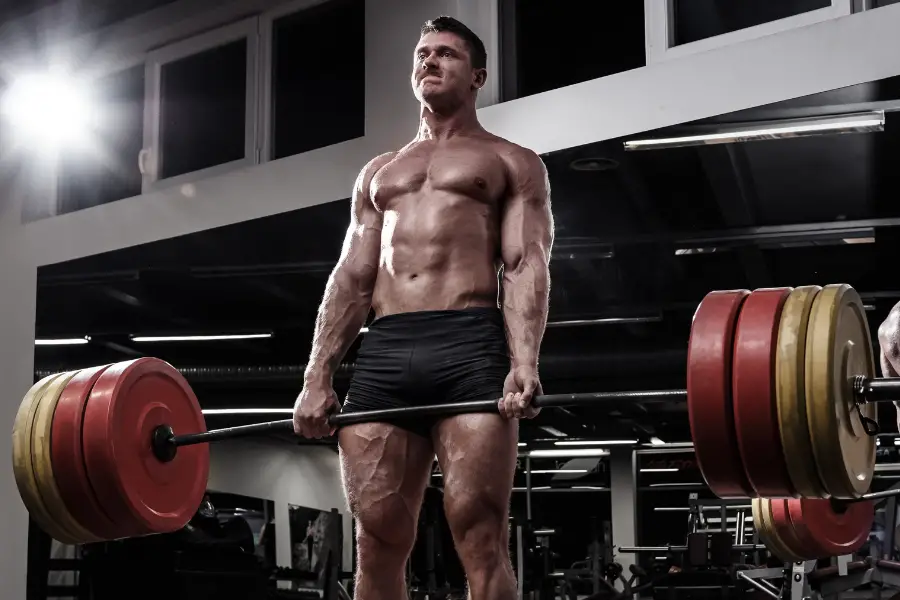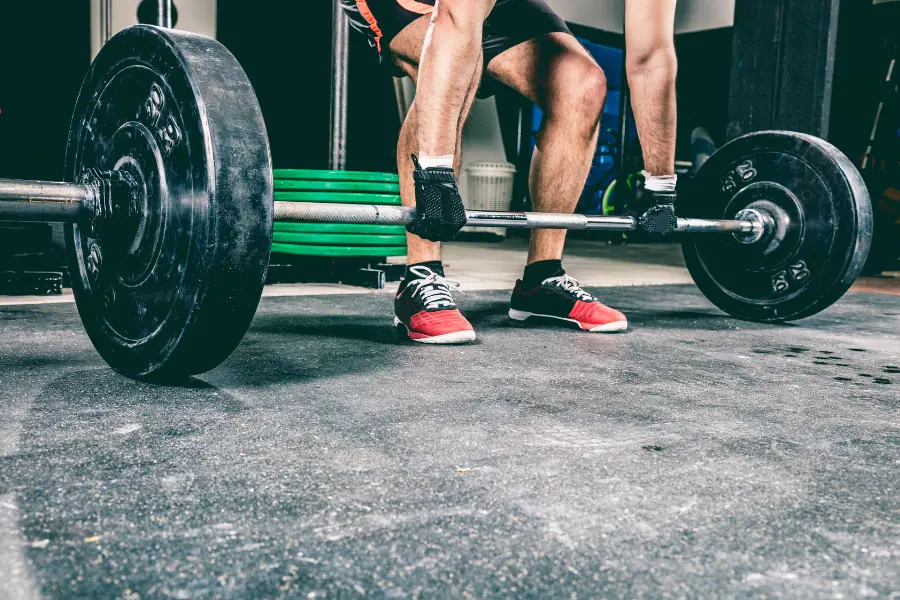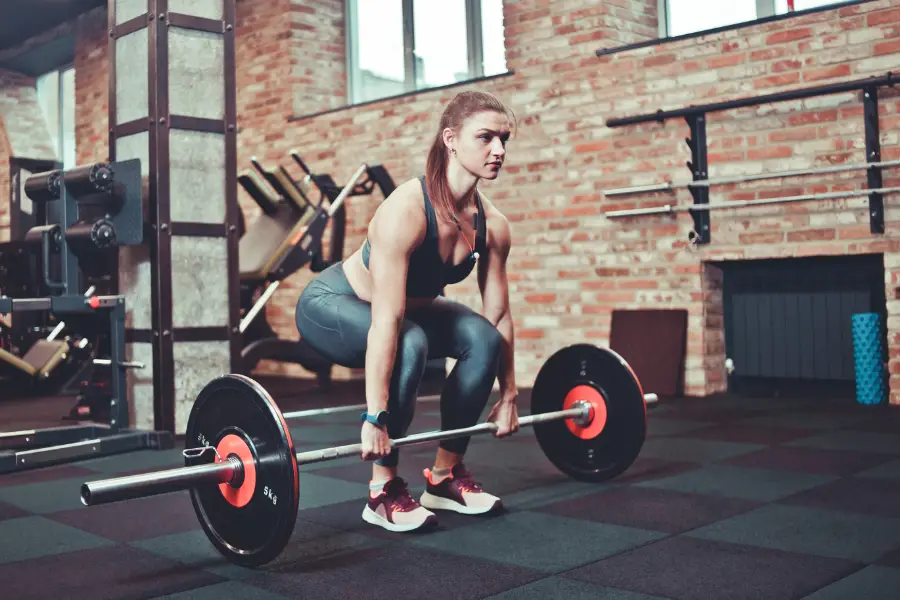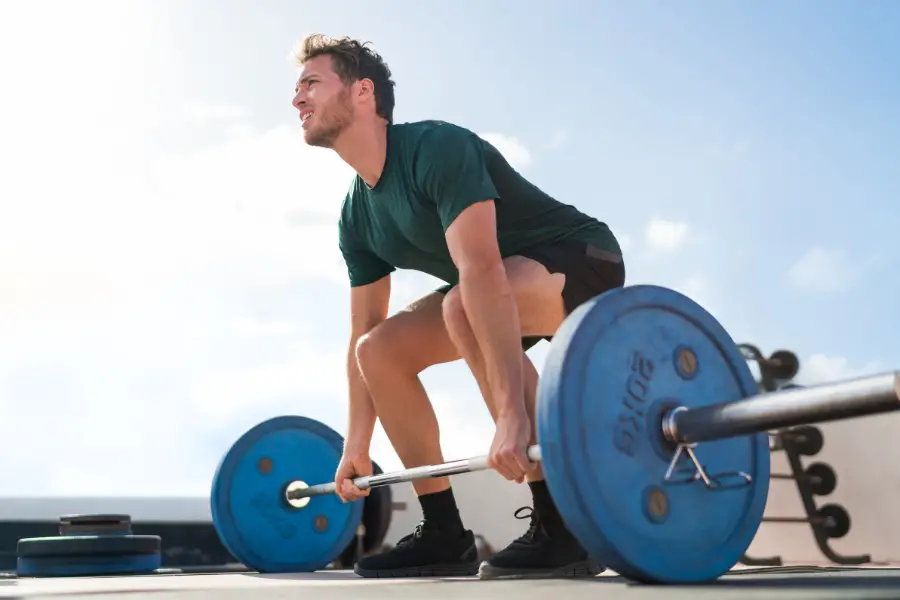Weightlifting at home is a good way to stay in shape without ever leaving your house. But it does create quite a lot of noise that can be problematic for your neighbors, housemates or even yourself. What can you do about this?
The best way to reduce noise while deadlifting or even on other types of lift is to lower the weights in a controlled manner. Prevent loud noises from being created and transferred by using rubber weight plates, rubber flooring and deadlift pads. Acoustic panels and rubber tiles also help.
Find out more about all the different strategies you can implement to reduce noise in your home gym below.
Contents
Why Is Dropping Deadlift Weights So Noisy?
If you’ve ever lived in an apartment you know that some noises are really easily audible for you as a neighbor. Most of the noises you can hear are impacts on the floor. That’s because the impact of something heavy will actually slightly vibrate the floor and turn it into a big speaker.
Dropping weights can create a level of vibrations that is easily audible for any neighbors or housemates and can be very irritating if it happens regularly. Besides that, weightlifting also creates quite a bit of noise inside your home gym. Metal parts clanking together is never going to be quiet although there are a few things you can do to make deadlifts and other lifts a lot quieter.
Want to just cover up the noise? Here’s how to get music in your home gym easily.

How To Make Deadlifts Quieter
Deadlifts and other lifts where people tend to drop the weights on the floor are usually the biggest offenders. This is where the impact is the strongest and therefore creates the biggest impact, noise and vibrations. If you have downstairs neighbors this really isn’t fun to sit under because it sounds like your ceiling is going to come down.
That impact is what we want to soften and minimize. If we can soften the impact enough, the noise and vibrations will also be greatly diminished. There are a few good ways to do this;
Lower the weights controlled
Since it’s all about minimizing the impact, the best first step it to get used to lowering your weights in a more controlled manner. Yes this does take some extra effort and can make deadlifts even harder to recover from. Many people (including me where possible) just let the bar go down while still holding on to it. This way you have minimal muscle activation on the way down. Since we all care about how much weight we get up but nobody cares about how much weight you set down, this is a natural way to do it.
Lowering the barbell in a slower, more controlled manner reduces the force of the impact and therefore the amount of noise and vibrations that is created.
It’s a good idea to have some mirrors to check your form as well. Deadlifting heavy requires good form and a mirror is a good tool to keep an eye on it. Better form on the way down means less noise as well.
Bumper plates

Steel plates are no good. Banging two hard surfaces against each other is not a good way to reduce noise. Rubberized steel plates like you see in most commercial gyms are a bit better and can work well in combination with some of the other strategies in this list.
For deadlifts, rubberized steel plates are OK because you don’t drop them all that far. In combination with a good floor, they will handle that pretty easily. However, if you’re dropping them from higher, it’s a good idea to get bumper plates.
Bumper plates are completely made from rubber. They are bigger for the same weight as a steel plate (usually thicker), and are made to be dropped repeatedly from overhead. Because they are made from rubber, the impact with the floor will be absorbed somewhat by the softer material.
This will reduce the sharp noise of the impact on the floor a lot. It will also reduce the vibrations that carry to the neighbors somewhat although only bumper plates by themselves won’t fix the noise problems.
One downside is that bumper plates will last shorter than normal steel plates unless you drop them from overhead. Since most home gym owners don’t do Olympic style weightlifting, rubberized steel plates are a better option.
Quiet down your plates
Metal weight plates banging against each other can actually produce a significant of noise when lifting weights. Rubberized plates prevent this to a large degree to where it’s acceptable.
If you’ve got bare metal plates, there are a few things you can do to make it quieter though;
- Use barbell collars: Barbell collars prevent plates from sliding off the sleeves. It’s a good idea to use them regardless of noise but if you use the collar to keep the plates tightly together, there is no room for them to bang against each other.
- Use fitting plates: Plates that have an inner hole that is much larger than the sleeve on the barbell can pivot more on the sleeve. This means they can bang against each other more easily because they can move in more directions. Higher quality barbells and plates usually have tighter tolerances.
- Add rubber/foam tape on the edge of plates: If the two tips above don’t help, adding some thick rubber or foam tape on the edge of the plates will get rid of most of the noise. It’s basically the same as having rubberized plates but in a much smaller area. Identify the surfaces where the plates touch each other and add tape there. It’s not pretty but it works well.
Flooring
If you have hard flooring or something not very solid at the moment, upgrading your gym flooring will make a big difference. For noises and vibrations to not reach the neighbors, you want to absorb as many of them as possible. Thick rubber is one of the better ways to do that.
Getting the thickest rubber gym flooring you can get your hands on is going to get the best results. The thicker it is, the more material there is to absorb noises. Good gym flooring is also easier to clean and makes your gym look awesome.
Also read this in-depth article on acoustic gym flooring
Of course it’s not necessary to cover the whole gym in the thickest rubber you can find. While that looks nice and works well, it’s also expensive. Just covering the location where you always lift and drop the bar can be enough.
If you just do a part of your gym, you have to be careful for ledges though. The thick rubber can create enough of a ledge to trip over. Try to minimize any of these ledges and make them clearly visible. Also, make it big enough so there is absolute no chance you step off the mat if something weird happens. You don’t want to make the mat so small that your feet slip off when you take one too many steps back with a heavy barbell in your hand.
Rubber tiles
While a good gym flooring is a better option than this, a stack of thick rubber tiles can be effective too. You can use them stand alone or on top of a good gym flooring. Thick rubber tiles are easily found as tiles for a garden playground or patio tiles. They don’t cost too much and basically just make the rubber flooring thicker.
These things are also great to modify the height of the barbell. Deadlifts are officially started with the barbell a little higher than halfway up your shins although that depends on how tall you are. If you’re just starting and using light (small) plates, the bar will be lower to the ground which means you’re putting yourself in a more compromised position to lift heavy weights.
Some rubber tiles can rectify that situation pretty easily. Do get ones that are big enough though. About 2’ x 2’ (61×61 cm) works best. That way you don’t have to aim your drop too carefully.
Find some great rubber tiles here on Amazon

Acoustic panels
Sound waves bounce on hard surfaces. That means you can hear one sound wave multiple times. Clap your hands loudly in your gym. Do you hear any reverb? If so, some acoustic panels can reduce the noise bouncing around. Hearing a loud noise only once instead of twice is much better.
Acoustic panels absorb sound waves. That’s what they’re made for. The type of foam used in acoustic panels traps sound waves and doesn’t let them out anymore. Covering the walls with some of these panels will usually reduce the noise levels in your gym.
Find a great set of acoustic panels here on Amazon
However, these panels work best for higher frequencies. They will work well for reducing the sharp noise of two hard surfaces impacting each other. However, it doesn’t do much for the low frequencies and vibrations dropping weights create.
Deadlift pads
All the things above are just the groundwork for this piece de resistance; deadlift pads. These things are basically airbags for weights. Deadlift pads are big square bags, usually made from a kind of vinyl or polyester. There is soft foam that holds a lot of air inside. When you drop the weights on it, the bag deflates so it slows down the weights before they hit the floor.
It works exactly like the airbag in your car. An airbag is just a bag of air that slowly deflates slows you down enough to prevent serious injuries and worse. Deadlift pads do the same thing so you don’t have the loud impact on the floor. The big difference here is that deadlift pads are always inflated if there is no weight on them and re-inflate automatically when the weight is taken off.
If you only want to buy one thing, this is it. They will quiet down your deadlifts very significantly. However, I think they work best in combination with some of the other things mentioned above. You’re free to pick and choose which ones you use though.
How to make weightlifting quieter
Of course all the tactics you can use to make deadlifts quieter, you can also use some of the ones above to make most other lifts you drop on the floor quieter. You can even use most of those with dumbbells.
But what other types of lifts? The type where you put the barbell on a rack of some sorts. Things like; squatting, overhead pressing an bench pressing. Usually those are a bit quieter than lifts you drop on the floor anyways because you put them back more carefully but, quieter is always better.
The problem is that on these lifts, the weight plates don’t actually touch the floor. It’s putting the barbell in the hooks that is the problem. Most solutions that make it quieter for the weight plates to hit the floor are going to absolutely nothing to reduce noise when racking a bar.
Here are a few things that will help;
Rubber on hooks
You want to prevent any noise and vibrations to get to the neighbors. When you rack a weight, there is usually some metal on metal contact. The metal frame of the rack will just transfer most of the noise to the floor. So preventing or absorbing those noises is the best way. Of course racking weights carefully will help a lot but so will putting some rubber on the barbell hooks also known as J-cups.
Cover the J-cups in rubber where the bar touches them. Just like rubber flooring this absorbs quite a bit of noise. This also prevents a lot of noise being created in the first place.
Rack on rubber
Sometimes it’s also possible to put a rubber layer in between the rack and the floor. Gym flooring does this. For many pieces of gym equipment this is not a problem. However, some power racks have to be bolted to the floor for stability. With those it’s more difficult to put rubber under it and even if you did, bolting it down would create a hard connection between the rack and floor.
Standalone power racks that don’t have to be bolted down and bench press benches are perfectly fine to place on top of rubber gym flooring though.
Other Solutions

Does none of the solutions above actually solve the problem in manner that’s good enough? Here are some other options that don’t involve making the impact softer but moves the problem around in another way.
Time
If the neighbors are complaining, are you deadlifting 500 lbs. in an apartment at midnight? If so, they probably have a point. That might be a bit of an exaggeration but the time you train has an impact.
Of course not everyone has the option to work out at any time they want but maybe you can reach an agreement with anyone that lives around you that you’ll limit your heavy lifting to certain hours. Some effort to solve the problem from your side will probably be appreciated although there is no pleasing some people.
Location
The final thing you can do is to change the location you lift in. If you’ve built your dream home gym it might be difficult to move. But if you just have a barbell and some weight plates, you might be able to find a different place to do your thing.
A different location in the house might be enough to solve the problem or maybe you’ve got access to a garage or shed? Asking around might yield a place you hadn’t thought of before.

